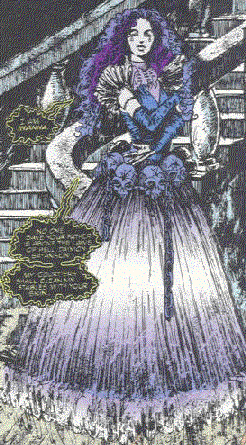 INANNA
INANNA
 INANNA
INANNA
Real Name: Inanna
Identity/Class: Goddess (Mesopotamian)/demon
Occupation:
Former goddess of love and war (and possibly
of heaven);
Demoness of Inspiration of Madness
Group Membership: Annunaki (Mesopotamian Gods)
Affiliations: Bailiff;
Bull of Heaven; Conan;
presumably worshipped by the Sisterhood
of Ishtar
(including
Indries
Moomji);
various demonic guards used to protect
the tower holding Isolene
Enemies: Jaine Cutter, Enkidu, Ereshkigal, Gilgamesh, Hellstorm, Lilith; Jack Wintergarden (victim/pawn); Isolene, Libro
Known Relatives: Tammuz (husband), Anu (name
unknown), Ki (Gaea; mother),
Ereshkigal
(sister-in-law),
Dagon/Enlil,
Ba'al
Hadad, Ninurta, Martu
Ningal (brothers),
Nergal, Marduk, Ullikummis (nephews);
Shamash (great-nephew), Anshar (grandfather), Kishar (grandmother9, Lahmu (great-grandfather), Lahamu (great-grandmother)
(NOTE: In Sumerian myth, Inanna was called the daughter of Anu
with Antum,
and the daughter of Enlil (Dagon), and the daughter of Nanna (Sin) with
Ningal.
She was so important, that she was considered a sister of all the
important
entities.
Family tree wise, this is impossible, but it just goes to show how high
importance religious wise she was to the tribes and empires of Ancient
Mesopotamia.
Also, in mythology, there are no terms as step-brother, brother-in-law
or
half-brother. In myth, "brother" was used in place for all these modern
titles.--Will
U)
Aliases: Alonia, Antimuse, Astarte, Ishtar
Base of Operations: Formerly a
realm of Hell;
Dilmun
(the realm of the Mesopotamian Gods);
Allatum (the underworld);
Ababenzzar
(Hyborian Era)
First Appearance: Conan the
Barbarian I#40 (July
1974);
(modern
era): Hellstorm#15 (June, 1994)
Powers/Abilities: As a goddess, Inanna
would possess superhuman
strength (Class 25), durability, and other physical characteristics.
She
is immune to the effects of aging and conventional disease. She also
presumably
possessed other attributes associated with her domains of love and war.
As a demoness, she possesses additional abilities, specifically in the
areas
of pain and madness. She has great magical powers, on par with other
arch-demons,
such as Marduk Kurios, Satannish, or Thog. Her powers are greatest within her
own
realm. In her name torture devices like the Brazen Bull, Bell Collar, chandeliers, Eye Cups, the Iron Collar and Mouth Pear were used by her Bailiff.
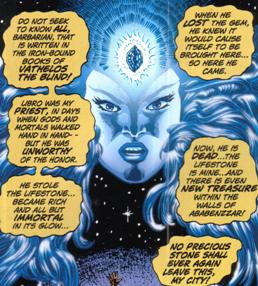
History: Inanna, also known as Ishtar, was one of the major goddesses in ancient Sumeria, but also earlier in the Hyborian Era.
(Hyborian era) - As Ishtar, she was worshipped by a number of peoples. In certain city states of Shem, she was worshipped in rich temples and at lavish shrines with rituals of blood sacrifice and orgiastic frenzy performed before sensuously carved idols of ivory. She was also worshipped by cults of small numbers in Aquilonia, Argos, Cimmeria, Koth, Nemedia,south of Nordheim, Ophir, Zingara, and portions of Shem (Asgalun and the desert Shemites)--though most in these kingdoms worshipped Mitra instead.
(Savage Sword of Conan#98/2 (fb) - BTS) - At some point during the days of the Hyborian Era, Ishtar became jealous of the beauty of the woman Isolene. So, she punished Isolene by placing her in a tower guarded by demonic beings. Ishtar apparently then forgot about Isolene.
(Conan the Barbarian I#40 (fb) - BTS) - "In the days when gods and mortals walked hand in hand", a man named Libro served as Ishtar's priest, presumably in the city called Ababenzzar. However, Libro betrayed Ishtar and stole her lifestone, a source of power. Achieving great wealth and immortality, Libro later somehow lost the gem. Libro knew that the gem would eventually again make its way to Ababenzzar.
(Conan the Barbarian I#40) - Conan happened upon Libro, whose horse had died in making the difficult trip, while Libro's mystical power had started to fade away. Telling Conan there was treasure in Ababenzzar, Libro was taken there. When they arrived at Ababenzzar, Conan discovered a group of thieves including Tassgorian, Oggar, Phandar, and Hamarr. Conan also encountered Ishtar, who went by the alias Alonia. Conan introduced Alonia to Libro, who recognized her as Ishtar. Libro, mustering his last bit of mystical might, summoned "a minion of Hotath and Helgor"-a demon. The demon killed the thieves, and then attacked Conan. Libro, content to watch the demon devour the Cimmerian, did not notice one of the thieves, just before he expired from the demon-inflicted wounds, grab a knife and fling it. The knife hit Libro in the back. Ishtar and Conan destroyed the demon, with Ishtar revealing herself as a goddess.
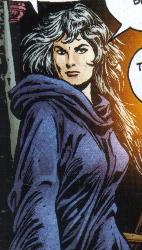
(Savage Sword of Conan#98/2 - BTS) - The incident with Isolene passed into legend, such that years later a venal aristocrat named Lord Julian, seeking carnal adventure, decided to free Isolene from the tower. He had false rumors spread which indicated that the demonic beings protected treasure, and then Julian watched the tower, expecting some gulled, treasure-thirsty patsy to show up and unknowingly kill the demonic guards for him. Conan showed up on schedule, and Julian saw the Cimmerian do everything he wanted him to, but not wanting to share Isolene with Conan, Julian attempted to kill the Cimmerian with a crossbow. He failed, and Conan grabbed Julian, forcing him to come into the tower with him. They discovered that Isolene, in the time it took for the story to become a legend, had died, and ravenous rats were eating her bones. Conan threw Julian to the rats in a fit of poetic justice.
(mythology) - Inanna fell in love with the demi-god-king, Gilgamesh (son of Ninsun the dream-goddess and the mortal King of Ur, Lugalbanda), and tempted him into promoting her worship. However, the warrior spurned her and she set out to gain revenge on him in various ways.
(Thor & Hercules: Encyclopedia Mythologica) - At some point Inanna was approached by Satan (Marduk Kurios), who tempted him with everlasting power. Inanna accepted the deal and was transformed into a demon.
(Captain America Annual#11 (fb) ) - As Ishtar, she
sent the Bull
of Heaven to Earth. Gilgamesh slew the Bull, but lost his close friend
Enkidu
in the process.
Some sources state that they slew the Bull, but Ishtar then demanded
one
of their deaths in retribution. Enkidu accepted death, allowing
Gilgamesh
to survive.
(myth) - Inanna was eventually attracted to Dumuzi (Tammuz), the fertility god. Ereshkigal, however, abducted Dumuzi to Allatum, which forced Inanna to come to him. Ereshkigal had Inanna embarrass herself by having her leave an article of clothing at each of the nine gates of the underworld. Appearing naked before Ereshkigal, Inanna was held captive until her half-brother Enlil ripped open the gates and rescued her. Dumuzi was forced to stay below as watchman of one of the gates, but as a god of spring, he was allowed a few months of every year to visit her in heaven.
BTS - Apparently after millennia without worshippers, Inanna degenerated from goddess to demon.
(Tower of Shadows#7/2 - BTS) - Ishtar was invoked by a gypsy to avenge her daughter killed by "Black John" Wollaston. The curse placed on the Wollastons endured for centuries.
(Hellstorm#15 (fb) - BTS) - Sometime in the
17th-18th Century, a Bavarian artist named Christoph
Haizmann
made a deal with the devil (actually Inanna). He sold both his house
and
his soul to her, in exchange for the ability to create disturbing
paintings.
His house thus became a safe territory on Earth for demons. The
inspiration
Haizmann purchased drove him quite insane, and Inanna and her allies
waited
for his death to establish an embassy of Hell in his house.
Haizmann bound the documents of the sale into a diary, scratched
pentagrams
and goat's heads all over it, and --utterly by accident--he happened
upon
a combination of symbols that put the contract on hold until such a
time
as those symbols were erased. After Haizmann's death, the house
remained
unoccupied for three centuries. Haizmann himself died in an asylum, and
his
soul went to Hell anyway.
(Hellstorm#12/15 (fb) - BTS) - In the modern era, a writer, Jack Wintergarden, on a writing holiday, saw and purchased the house. He had the mansion transported to Florida brick by brick. Wintergarden then threw a party and invited all of his family and friends. During the party, Wintergarden's two-year-old son found Haizmann's diary and threw it into the fire, destroying the symbols which barred the presence of the demons. Inanna's bailiff slaughtered and tortured Wintergarden's family by most horrible means (ever read Ellis' work?), while Jack himself was forced to watch. The dark energies present drove psychics all over the state of Florida temporarily insane.
(Hellstorm#15) - Hellstorm and his ally/lover, Jaine Cutter, came to Haizmann's house after learning of these events through Anton Devine. They confronted the Bailiff who was kind enough to explain several of the torture devices before preparing to slay them. Since the house was technically a realm of Hell, the Bailiff knew that Hellstorm would be powerless to interfere in the affairs of an arch-demon such as Inanna. However, the Bailiff did not know that Hellstorm had slain his own father, Marduk, and had ascended to the position of lord of his own realm of Hell. Hellstorm obliterated the Bailiff, and Inanna responded by appearing within the house herself. Cutter then used the Breathing Gun, a weapon able to slay demons, to destroy Inanna.
Comments:
Ishtar is a prominent member of the Conan
mythos, established by Robert E. Howard.
She was first shown on-panel during the Hyborian Era in a story by Roy
Thomas
and Rich Buckler and Ernie Chua, adapting a plot by Michael
Resnick.
She was adapted to the modern era by Warren Ellis and Leonardo Manco.
There is some evidence
that she was worshipped even off of
Earth, as Sandy of Pryd'ri invoked the name of Astarte in the Star-Lord
story
in Marvel Preview#11.
Also, Ms. Marvel (Carol Danvers), who had
gained the mindset
of a Kree warrior, also invoked "Astarte's Crown," @ Ms.Marvel#13 or
so...
--Both of these stories, by the way, were written by Chris Claremont.
Here's an interesting interpretation
of Inanna,
as another form of Venus, courtesy of Will U:
"Inanna was the Goddess of love, daughter of Zeus and
Dione(Antum). After
Hera became queen of Olympus, many of Zeus's loves left Olympus with
Leto
taking refuge on the island of Delos where Apollo and Artemis were born
and
Io eventually fleeing to Egypt after being turned to a cow where
Epaphus
was born. Dione fled to the island of Cythera where Aphrodite was born.
Swimming
in the sea there led to the myth she born from it. Both the goddesses
found
asylum in the realm of the Mesopotamian gods where Anu took Dione as
his
wife. Renamed Antum and later Asherah, she gave birth to Enlil,
Ninurta,
Hadad and Martu, Sumerian gods of wind and storm with obvious Olympian
attributes. Aphrodite was adopted by Anu and called Inanna, later
Astarte,
Ishtar and other names.
Some generations later, the Phoenician Empire fell to the Greeks. As
Zeus
and Anu reached a peaceful truce, Dione stayed as Queen of the
Mesopotamian
Gods, but Aphrodite left for her Olympian heritage. For some
compensation,
Zeus seduced the Phoenician princess Europa and in the form of a bull
abducted
her to Crete where she became ancestor to the ruling Houses of Crete,
Argos,
Mycenae and Tiryns. Inanna vanishes from the Mesopotamian stories as
Aphrodite
appears out of nowhere in Greece. The love goddess still favors the
other
side of the Mediterranean and later returns to seduce the Phoenician
prince
Adonis and much later make trouble for the Phoenician princess
Psyche."
William also believes that Inanna, Marduk, and other gods who have apparently degenerated into demons are not the gods themselves, but demons impersonating them. Warren Ellis had an interest in the Babylonian Gods, and he definitely intended his characters to be those gods. For further discussion of this, see Marduk's comments.
Gilgamesh, in the Marvel Universe, actually is an Eternal.
Additional mythology
info taken from the Dictionary for Pagan
Gods:
ISHTAR; to the Sumerian INANNA; to the Egyptians, ASTARTE The
greatest
of all the mother goddesses of the Mesopotamians. Goddess of fertility,
goddess
of sex, goddess of the moon, goddess of war. Lady of heaven, lady of
sorrow
and battles. The great lover, the great mother. The hero-god Gilgamesh
spurned
her, ensuring his death. Venus is her star, and the lion is her cult
animal.
Ishtar's love is all consuming and even deadly. An Egyptian sculpture
portrays
her nude, standing on a lion, and holding a lotus blossom (the symbol
of
life) in her right hand. Ishtar's worship involved phallic symbols,
sacred
whores and painted priests in women's clothing. At her shrine at Uruk
the
priestesses performed a sexual rite in her honor. A priestess played
the
goddess; the priest who played the god was slain. The Christians turned
her
into a demon, and she is mentioned as such in Milton's PARADISE
LOST.
And you can get more mythology info at similar sites, such as The Sumerian Gods FAQ. Look under both Inanna and Ishtar for the most info.
Babylonian Gods rank
right up there with Lovecraft's work
as one of the most common sources of demons in the MU: There's Ba'al,
Inanna,
Lilith,
Marduk,
Ningal,
Nergal, Ullikumis, that I can come up with off the top of my head.
I had mentioned previously that I thought these gods may have
degenerated
into demons due to millennia without worship. To clarify: I didn't mean
that
any god without worship would automatically become a demon after a
given
period. It just seemed like one possible motivation/explanation.
However,
the Mesopotamian Gods seem to have been particularly susceptible to
this
phenomenon. They have had the longest time to...spoil.
The Isolene story reminds one of the fits of jealousy Aphrodite had in Greek myth (Psyche comes to mind), or of a Classics Desecrated/horror version of Sleeping Beauty.
In the Annunaki entry in All-New OHotMU Update#3 it was cleared up that Anu was Inanna's father.
CLARIFICATIONS:
No known connection to:
The Bailiff
of Inanna acts as her agent.
The Bailiffs are apparently a race or group of demons, and the one who
served
Inanna is not the same as the one who subsequently served Hellstorm.
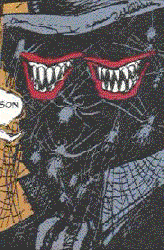 The
Bailiff came to Haizmann's/Wintergarden's house after the diary
barring their presence was destroyed. He orchestrated the torture and
slaughter
of Wintergarden's family as part of the means to inspire Wintergarden's
writing.
The Bailiff could have just given Wintergarden visions of violence and
intense
dreams, but he chose to inspire him by slaughtering his family because
it
pleased him to do so. He was blown apart by Hellstorm.
The
Bailiff came to Haizmann's/Wintergarden's house after the diary
barring their presence was destroyed. He orchestrated the torture and
slaughter
of Wintergarden's family as part of the means to inspire Wintergarden's
writing.
The Bailiff could have just given Wintergarden visions of violence and
intense
dreams, but he chose to inspire him by slaughtering his family because
it
pleased him to do so. He was blown apart by Hellstorm.
The Bailiff derives great power from Inanna, enabling him to overpower
a
large group of people, as well as a powerful warrior such as Jaine
Cutter.
He is unable to be injured by conventional means, and it requires even
advanced
mystical power to harm him. He can open portals in space, and extend
powerful
serpents from his body to bind and attack others. His knowledge of pain
and
torture is extensive.
--Hellstorm#15
Among the devices he used on Wintergarden's family were:
The Bell Collar, an obscure Italian invention. The slightest movement of the victim rings an unusually loud bell above him or her. The wearer is usually sent irretrievably mad within two days.
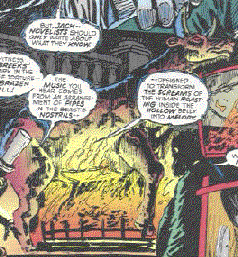
The Brazen Bull, a creation of the Greeks. Victims are placed within the hollow belly of the beast, and an arrangement of pipes in the beast's nostrils transforms the victim's screams into melody. Wintergarden's daughters were placed within the Bull.
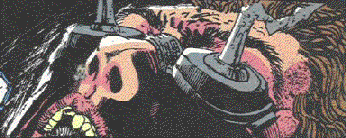 The Eye
Cups, an ancient Persian device. Acid is slowly poured
into the
channels, inescapably bathing the eye sockets in corrosives. The
Bailiff
found the hissing sound this produced to be quite soothing.
The Eye
Cups, an ancient Persian device. Acid is slowly poured
into the
channels, inescapably bathing the eye sockets in corrosives. The
Bailiff
found the hissing sound this produced to be quite soothing.
Fearful Eliza, the Spiked Rack...no explanation necessary. This was intended for Jaine after the Bailiff would have finished using the Mouth Pear.
The Iron Collar, a Chinese device. It is placed around the necks of victims, who were then suspended by it, until their own weight began to pull it through their skin.
The Mouth Pear, a Spanish device. The pear is inserted and the screws are turned, causing the pear to unfold, smashing the lower half of the face. The Bailiff was preparing to use this on Jaine before Daimon stopped him.
a set of chandeliers using flaming heads of live (initially, anyway) victims as lights.
Jack Wintergarden is a writer who dabbled in the occult. He purchased Haizmann's house which led to the release of the demons of Hell back into it. His family was slaughtered and tortured by the demons, and he was forced to watch. He was saved from the Bailiff and Inanna by Hellstorm, although his subsequent fate is unknown. Hellstorm may likely have chosen to punish him, or he may have taken his own life.
Appearances:
Tower of Shadows#7 (September, 1970)
Conan the Barbarian I#40 (July 1974) - Roy Thomas (writer/editor), Rich
Buckler (pencils), Ernie Chan (inks)
Savage Sword of Conan#98 (March, 1984) - Steve Skeates (writer), Gary
Kwapisz (artist)
Captain America Annual#11 (1992) - Roy Thomas (writer), Larry Alexander
(pencils), Kathryn Bolinger (inks), Ralph Macchio (editor)
Hellstorm#12 (March, 1994) - Warren Ellis (writer), Leonardo Manco
(artist), Marie Javins (editor)
Hellstorm#15 (May, 1994) - Warren Ellis (writer), Leonardo Manco
(artist), Marie Javins (editor)
Thor & Hercules: Encyclopedia Mythologica (2009) - Anthony Flamini, Greg Pak, Fred Van Lante & Paul Cornell (writers), Jeff Youngquist (editor)
First Posted: 04/13/2002
Last updated: 03/20/2014
Any Additions/Corrections? please let me know.
All characters
mentioned or pictured are ™ and ©
1941-2099 Marvel Characters, Inc. All Rights Reserved. If you like this
stuff,
you should check out the real thing!
Please visit The Marvel Official Site at:
http://www.marvel.com
Special Thanks to www.g-mart.com for hosting the Appendix, Master List, etc.!